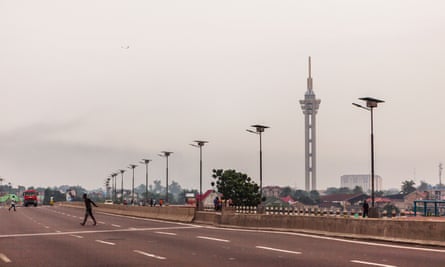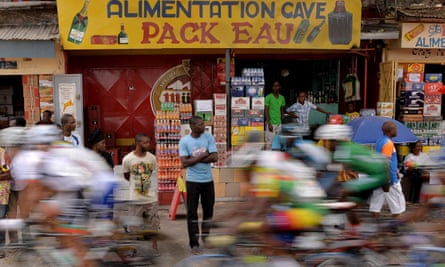Sunday morning, and the crowds are thronging the myriad churches on the ragged western edge of Kinshasa. Congregations file into the barn-like halls to hear priests and preachers. Down on the terrace of Chez Tintin, one of Kinshasa’s best known restaurants and nightspots, only fishermen and two tourists from the central town of Kisangani brave the warm, driving rain.
Beyond the plastic tables and chairs, a low brick wall, and the pilgrims, is the Congo. Though 4,500km from its furthest source, the great river is less than 1,000 metres wide at this point, and surges through the narrow bottleneck with tremendous power. The resulting rush of foaming brown water is the reason for the existence, the proximity and the enmity of arguably the world’s two closest capital cities: Kinshasa, of the Democratic Republic of Congo, and Brazzaville, of the confusingly similarly named Republic of Congo.
Upstream, the river broadens and is navigable deep into the interior. But below the rapids, all the way to the Atlantic Ocean 450km away, the Congo is impassable.
This geography was of crucial significance in the late 19th century when France and Belgium established rival colonies on the Congo’s banks. Ivory, rubber and other commodities could be brought as far as the rapids, but no further. To bypass them, each built a railway to the Atlantic Ocean. The Belgians built theirs on the southern bank in the 1890s; the French followed 30 years later on the northern. The tracks began at the last possible point where goods could be carried by ships: the current sites of Kinshasa, and Brazzaville, named in honour of Pierre de Brazza, the young French explorer who pioneered Paris’ acquisition of the territory.
The birthright of the cities is thus suspicion and rivalry. For nearly 150 years the two have been divided by their shared origins and the famous river which runs between them.

When Joseph Kabila, the 45-year-old president of what has been the DRC since 2001, looks out of his heavily guarded home on the river’s banks in the centre of Kinshasa, he will see, directly opposite, the span of a vast new bridge, illuminated at night with sprays of pink and yellow light.
This is the Route de la Corniche, a prestige project which spans a valley over a minor tributary on the river’s northern bank separating two wealthy neighbourhoods of Brazzaville, where his counterpart Denis Sassou Nguesso, 73, has been ruling since 1979 (with a five year break during civil war). It is, says one western diplomat, “a bridge to nowhere” and is an adequate representation of the relations of the two countries.
There is a flight twice a week between the two ridiculously close capitals – “Welcome aboard, our flight time today is five minutes” – but the Congo is the main link, and that means the heavy, rusting ferries and the faster but terrifyingly flimsy speed boats which bounce over the waves.
Professor Kambayi Bwatshia lives in a small villa in central Kinshasa where he has watched regimes on both sides come and go. He has also watched the two cities – Kinshasa with a population of 12 million, the other three million – steadily grow. Bwatshia teaches in universities in the two cities, taking the ferry across to lecture students on international relations and culture.
“Going in either direction is a homecoming,” Bwatshia says. “The populations of Brazzaville and Kinshasa have never seen the river Congo as a wall, a closure … but as a passage, a route for coming and going to see a friend, a brother, a partner. The two peoples are one and the same, sharing politics, economics, commerce, spirituality and faiths.”
Bwatshia believes the divisions between the twin cities are a legacy of European imperialism. “It was the colonial powers which created this divide, a divide which entered into the spirit of people, as it has done elsewhere across Africa,” he says.
King Leopold II was forced to hand the DRC over to the Belgian government in 1908. The colony, after decades of horrific mismanagement and exploitation, did not gain independence until June 1960. Brazzaville, which had played a key role for the French during the second world, followed two months later as a free nation.

“Each colonial power exploited its colonies according to it own objectives, mentality and values. That has been a major influence on the two cities and their relationship. The two peoples became almost enemies, and remained so until today … The river, once a bridge, became a wall,” said Bwatshia.
One key factor was the cold war. In 1965, Joseph Mobutu (who later renamed himself Mobutu Sese Seko) a former soldier and journalist, took power of the Belgian Congo. On the other side of the river, three years later, it was Marien Ngouabi, a leftist former paratrooper who took control and declared a Marxist–Leninist state. Mobutu, despite his brutality and venality, was supported by the west as a bulwark against Communist expansion. The Republic of the Congo, or Congo-Brazzaville as it is often known, broke diplomatic relations with the US, leaning towards the Soviet camp though it was wooed by its former colonial masters, or at least French businesses.
Both are scarred by the architecture of the time. Kinshasa is still full of crumbling monuments to Mobutu’s 32-year rule – such as his 200m Tower of Limite from 1971, a monument to Congolese independence leader Patrice Émery Lumumba – while Brazzaville is dominated by the 108m Nabemba Tower, an office block built with funds borrowed from French oil companies in the early 1980s.
The two capitals have been intertwined in more recent events too. As the author Michela Wrong drily writes in her account of the last years of Mobutu, In the Footsteps of Mr Kurtz, the fact that the two capitals are “within easy shelling distance of each other” has been “of more than merely abstract interest”.

Wrong wrote: “From Brazzaville to Kinshasa, from Kinshasa to Brazzaville, residents ping-pong irrepressibly from one to another … depending on which capital is judged more dangerous at any given moment.”The ebb and flow of violence has since led more people across the river, in both directions.
In 2001, Laurent Kabila, Joseph Kabila’s father and the rebel leader who took over from Mobutu, was shot by a teenage soldier in his palace. At least three of those involved in the plot, including the unnamed killer himself, reportedly fled Kinshasa, crossed the river and may have gone into hiding in Brazzaville. A supposed attempt in 2011 on Joseph Kabila’s life blamed on the northern neighbours led to major breakdown in diplomatic relations, which is yet to be patched up.
Tens, possibly hundreds of thousands of DRC citizens who have found work in Brazzaville face periodic expulsions. Many were already displaced within DRC and now live in desperately poor camps around Kinshasa.
But the sheer disparity in size between the two nations – the DRC with a population of 80 million, Congo-Brazzaville with less than five – and the two cities, is a factor that restrains any outright hostility.
In recent months, as the DRC has slid into a bloody political crisis, anxious looks have been cast in both directions across the fast-moving waters between the two capitals.

Kabila failed in a bid to change the constitution to allow himself to stand for a third term and his electoral mandate expired in December, prompting widespread violence in which more than 40 people are thought to have died.
In 2015, Sassou held a referendum to change Congo-Brazzaville’s constitution to allow him to stand for a third presidential term. He went on to win elections held last year.
Both rulers are accused of nepotism and corruption – which they deny.
With less than 24 hours before Kabila’s mandate officially ended, the ferries between the two capitals were busier than usual. Through the rusting gates, beyond the money changers with their stacks of eroded Congolese francs and the photocopiers where vital documents could be duplicated or triplicated, scores queued for tickets in the sweltering heat. Porters lugged suitcases, plastic bags wrapped in twine, multicoloured sacks and children. Armed police cradled Kalashnikovs and watched the chaos.
“It isn’t the English channel,” said Nzuzi Sitalina, the principal administrator of the port.
For some, the purpose of the trip was relatively mundane: to stay with relatives over Christmas, to retrieve some property, and trade sugar for cheap clothes. For others, the trip was more urgent.
A luxury 4x4 drew up metres from the ramps leading to the ferries. A tall slim woman emerged, flanked by a heavy-set man carrying a radio. Six porters were rapidly hired, and five giant suitcases plus an Italian-manufactured baby seat distributed. Four surly teenagers wearing baseball caps and skinny jeans followed. They were on their way out, one said, to escape the violence predicted for the following week.
Despite the political tensions between the two capitals, and the legacy of two very different nations’ imperialism, and even the limits to commercial, social and intellectual exchange imposed by the unbridged river, the 15 million on both banks are drawn inexorably together.
Feasibility studies are reportedly being carried out for a 4km, $1.65bn road and rail bridge linking the hearts of Brazzaville and Kinshasa. These are not the first such efforts. Half a dozen studies have been undertaken. It is unlikely that anyone is going to put up the kind of sums required in the near, or even distant, future for such an epic project.
In the meantime, the ferries ply back and forth, the students, teachers, traders and politician’s fugitive families still flow between the cities, and the rapids continue to entertain the diners at Chez Tintin.
Follow Guardian Cities on Twitter and Facebook to join the discussion, and read more articles in our Border cities series here

Comments (…)
Sign in or create your Guardian account to join the discussion